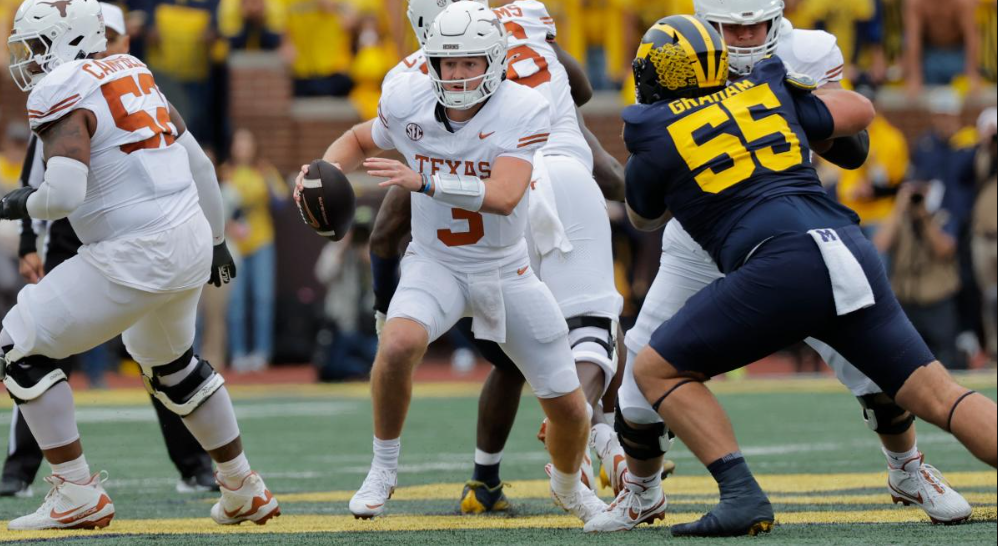
The SEC and Big Ten are in talks about a possible scheduling agreement that could dramatically boost media rights revenue, further setting them apart from the rest of college football, according to four sources familiar with the negotiations who spoke to USA TODAY on the condition of anonymity due to the sensitive nature of the discussions.
These sources indicated that the two powerhouse conferences might compete in as many as 12 to 16 nonconference games each season—possibly even more—aimed at maximizing revenue from media rights.
This potential agreement is seen as a response to significant financial losses stemming from a legal settlement exceeding 2billionforformerplayers,aswellasfuturerevenuesharingwithplayersprojectedat 20 million to $ 23 million each year, starting as early as the 2025 season.
An industry insider noted that increasing the volume of high-profile nonconference games over a set timeframe could be the key to maximizing revenues, a strategy that could be negotiated and formalized.
SEC, Big Ten aligning for new revenue frontier
This season, the SEC and Big Ten had just three nonconference matchups: Southern California vs. LSU, Alabama vs. Wisconsin, and Texas vs. Michigan. All three games ranked among the top 10 in viewership during the season’s first month. However, hosting only three games each year won’t significantly impact the lucrative agreements the conferences have with television partners—ABC/ESPN for the SEC and Fox, CBS, and NBC for the Big Ten.
More nonconference games—particularly those that can be marketed and sold as standalone events, similar to the annual Big Ten vs. ACC basketball challenge—could attract unique advertising revenue and be enticing for broadcast partners.
There are several obstacles to navigate, such as determining the schedule structure, how games will be paired, and the distribution of revenue. Nonetheless, officials from both conferences view the potential agreement as a solution to the rapidly evolving financial landscape of college football.
Private equity is another possible source of revenue, but SEC Commissioner Greg Sankey and Big Ten Commissioner Tony Petitti stated last Thursday that this isn’t a viable option.
Last week, the two leading figures in college sports gathered in Nashville with athletic directors and other conference officials, highlighting a process that has gained momentum since the SEC and Big Ten announced in February their collaboration as an “advisory group” to guide college athletics through a period of financial and operational instability.
How much new revenue could a deal bring?
The House settlement and anticipated future shared revenue with players highlight the urgent need for new sources of income—what one insider termed “clean revenue.”
So, how much new income is needed?
Sufficient revenue to capitalize on emerging financial opportunities, as noted by another industry expert.
However, what seems like a straightforward exchange is complicated by specific considerations: How many conference games will the SEC and Big Ten have (eight or nine), and how many of their combined 34 teams will be available for the proposed matchups?
Equally important are questions about how to divide the revenue. If the conferences decide to pool non-conference games, could this ultimately lead to advantages through shared media rights revenue for greater financial stability in the future?
Is there a possibility that the Big Ten and SEC could collaborate on a significant rights deal across various networks instead of negotiating separate agreements for each conference?
A Big Ten athletic director shared with USA TODAY Sports that all options are being considered.
How Big Ten, SEC could change football schedules
The entire process starts and ends with structure. Currently, the Big Ten plays nine conference games, while the SEC plays eight.
If the SEC increases its games to nine, it could lead to up to 12 new nonconference matchups between the two leagues. Conversely, if both conferences opt for eight conference games, there could be potential for 20 or more nonconference games.
Four SEC schools—Florida, Georgia, South Carolina, and Kentucky—have in-state rivalries with ACC teams that they want to maintain. Additionally, Southern California (with Notre Dame), Oregon (with Oregon State), and Washington (with Washington State) also have protected nonconference rivalries.
These seven schools are concerned about a future nine-game conference schedule that includes a nonconference game against their current rivals, along with another matchup from the new agreement. This arrangement would restrict them to just one flexible home game for revenue within a 12-game schedule.
Four of these institutions—Florida, Georgia, USC, and Oregon—are major television draws, making them crucial for any media rights deals involving nonconference games.
“We had a significant discussion about the possibility of playing each other more,” Petitti remarked after Thursday’s meeting. “We discussed how to approach this, what games we want, and how many—it’s a broad conversation.”
This discussion occurs in a context that clearly favors both super conferences, which have outpaced the rest of the FBS financially and would only widen that gap with a nonconference scheduling agreement.
However, the Big Ten and SEC want to avoid any appearance of collusion. It’s no coincidence that both conferences brought legal teams to last week’s meetings to navigate potential concerns.
“Can we be intentional about our scheduling?” Sankey posed, recalling his experience in Ann Arbor last month when Texas faced Michigan. “It was an incredible moment. Standing on the sideline before kickoff, I couldn’t help but think, ‘What if we could do this more often with our nonconference games?’”

Leave a Reply